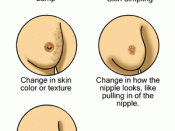Abstract
Breast cancer elicits so many fears, including those relating to surgery, death, loss of body image and loss of sexuality. Managing these fears can be facilitated by information and knowledge so that each woman can make the best decisions concerning her care. Optimally, these issues are best discussed with the patient's doctor on an individual basis. What follows is a review of information on breast cancer intended to aid patients and their families in their navigation through the vast ocean of breast cancer issues.
Needs Assessment
The major objective of our study is to investigate the relationship between depression dysfunctional attitudes, and their possible effect on quality of life in this special cultural environment. The impact of some demographic factors previously investigated in relationship to these constructs will also be explored. According to Finifter, Jensen, Wilson & Koenig (2005) a collaboration of the following three-step process, if used correctly, should be an effective process when conducting a community needs assessment.
"Component 1- Assessment, Empirical, Comprehensive. Component 2 - Dissemination, action orientated. Component 3- Implementation, Action orientated (Finifter, Jensen, Wilson & Koenig, 2005 p.294)." Component one includes a collection of primary and secondary data and a case study is usually constructed to gain an understanding of the particular issue. In our study of breast cancer and depression will be assessing depression and depressive symptoms, dysfunctional attitudes and quality of life.
Depression and depressive symptoms
Depression and depressive symptoms were assessed by the shortened, nine-item version of the Beck Depression Inventory (BDI). This inventory has been found to be a reliable measure of depressive symptoms, and symptom severity both on Hungarian and Romanian populations (Kopp & Skrabski, 1996; Rozsa, Szadoczky, & Furedi, 2001). In this study the internal consistency for the scale was .87 (0= owest score, 27=maximal score).
Dysfunctional attitudes...


